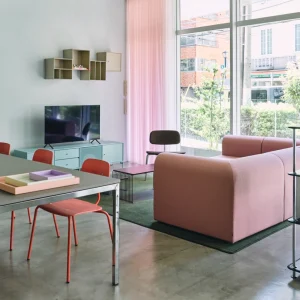The Spontaneous City follows an intimidatingly impressive pedigree of Dutch masterplanning. Perhaps because of the need to design longterm solutions for a flood-prone and high-density country, planning seems to run in the blood among architects in the Netherlands. The most prominent figure in recent years is, of course, Rem Koolhaas who set up his Rotterdam-based Office for Metropolitan Architecture in 1975 and is revered for pioneering the technique of condensing city visions into book/magazine hybrids. Publications like Mutations and Content, joined by MVRDV’s KM3 and FARMAX along the way, are ambitious and propositional but are also, notably, filled with rigorous analysis and statistics. They have proved incredibly influential on the architect’s role in urban planning and also on architectural publishing.
One urban planner who has clearly been influenced by this ancestry is Gert Urhahn, who, in 1991, set up Urhahn Urban Design (UUD) – the team behind the Spontaneous City. Intriguingly, though, this group seems determined to emphasise the novelty, rather than the continuity, of its position: within the first chapter, Amsterdam-based UUD holds the usually invincible Koolhaas to account for his masterplan of Binckhorst, an industrial area of The Hague. UUD observed that OMA had committed far too little research on the value of what already existed with its masterplan consisting of ‘95% ambition and 5% actual plan’.
To counter, UUD suggests a more uncertain process, driven by bottom-up initiatives where there is no single end goal. This approach places greater importance on the interim period of transformation, when further opportunities for intervention are presented. The Binckhorst project is used to illustrate a wider point: with the sudden disappearance of major financing, the days of the city-scale masterplan are over. The authors hope that this book can be a manual for reinventing the city, but it is also a heartfelt call for urban designers and architects to reinvent themselves. We must accustom ourselves to the idea of the city as unfinished: ‘it always has surprises in store’, says Urhahn.
A short and snappy introduction leaps straight into a manifesto for this new approach. The Spontaneous City is evocatively introduced as a market place where supply and demand sculpt urban form, and the manifesto is laid out in four pragmatic principles: zoom-in, supervise open developments, create collective ideals, and be user-oriented. Typical of Dutch visions, there is no shying away from the presence of a commercial imperative (often the persona non grata in other countries). There is a clear intent that this proposal should thread itself into real developments and not remain locked in theory.
The Spontaneous City is by no means an entirely new idea. The authors acknowledge this and set their ideas in a context that has been brewing for some time, even if it has generally been an exception to the rule. The book follows its stark, no-frills manifesto with an illustration: it is a genealogical grid presenting 100 years of the Spontaneous City – kicking off with Patrick Geddes, the ‘godfather of urban planning’.
The main bulk of the book comes in seven chapters that present the fundamental characteristics of a Spontaneous City and its users: entrepreneurial, inventive, flexible, open, independent, multifaceted and dynamic. The book is a collaboration with Partizan Publik, a ‘design and action’ collective based in Amsterdam, but which is also part of a network stretching to Beirut, Detroit, Moscow and Tbilisi. Indeed, a pluralist approach runs through the book; architects, urban designers and planners are allowed a platform, as are developers and investors. Consequently the book’s quick pace never sinks into a rant.
Despite the economic pragmatism, this is not a sad reflection upon an age of thriftiness and dried-up opportunities. The book successfully conveys the excitement of a Spontaneous City through a rich mix of essays, interviews, cartoons, and exploded diagrams. Together, they paint a picture of unpredictable events becoming the framework for a new system of planning. It highlights the inspiring fact that it is now individuals and small businesses that have the chance to instigate projects and actually see them realised.
Contributors Joop de Boer and Jeroen Beekmans run the online magazine Pop-Up City, which seeks out temporary projects of all shapes and sizes from across the globe with an analytical eye (London’s own Cineroleum featured in it last year). They point out: ‘It is not about the spontaneity of the intervention, but about the spontaneous social interaction it brings out.’ All of a sudden, the whole Spontaneous City becomes greater than the sum of its small-scale parts.
The Spontaneous City, Urhahn Urban Design, BIS Publishers, £28








